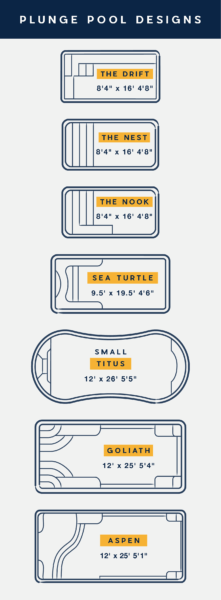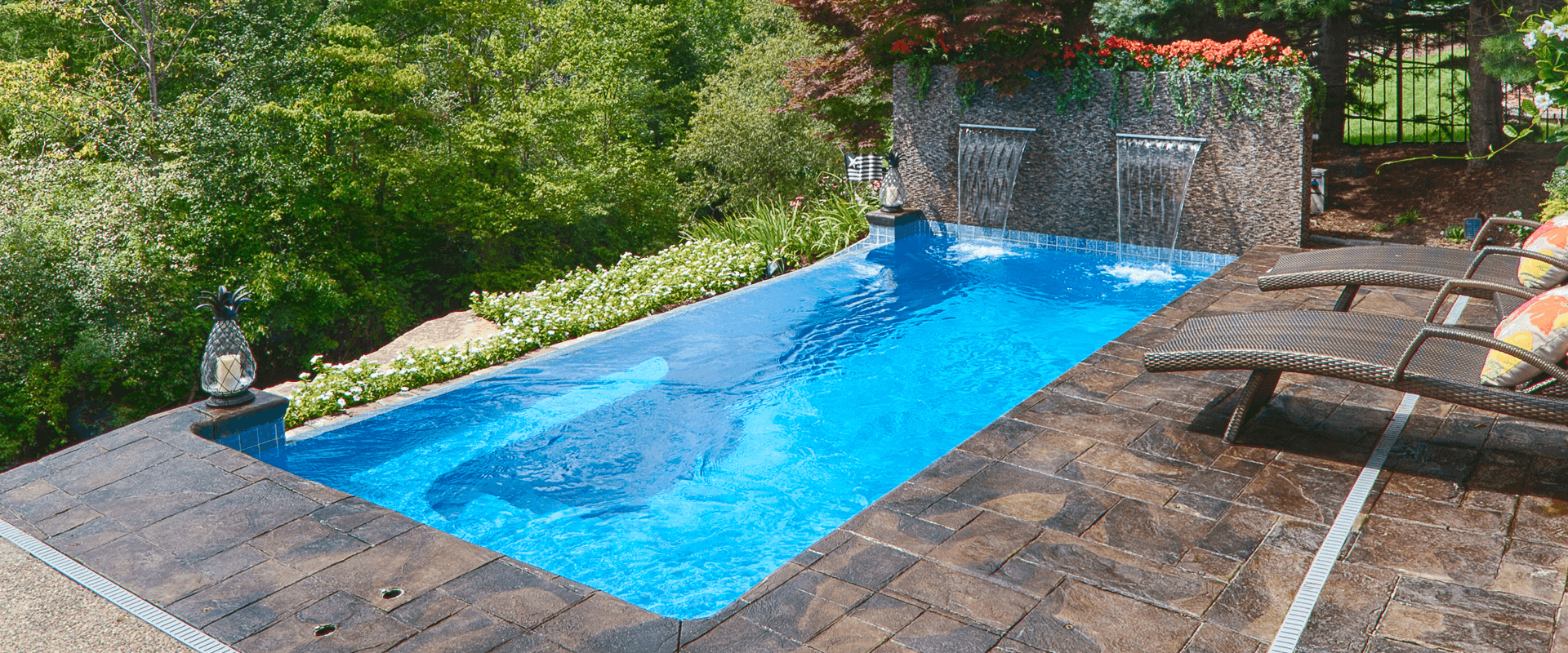877-929-7665
WHAT DO YOU CALL A SMALL INGROUND POOL?
While there’s no universally accepted or established definition for what counts as a “small” inground pool, models measuring around 400 square feet or less typically fit the description. Are you asking yourself, “What kind of pool do I need for a small backyard?” You’re likely to come across a variety of different names in your research, including some of the most common terms we hear people use to describe compact pool options:
- Wading pools
- Cocktail pools
- Spools
- Plunge pools
Homeowners often use the terms interchangeably to describe smaller pools, but there are important differences to note.
WHAT IS A WADING POOL?
Shallow wading pools aren’t for traditional swimming, but they can create a beautiful backyard water feature for those who want to enjoy the aesthetic. Typically around just 18 inches to 2 feet deep, wading pools are ideal for lounging and sunbathing in cool water on a hot day. With attentive and appropriate adult supervision, they are also great for toddlers and small children who aren’t yet capable swimmers.
WHAT IS A COCKTAIL POOL?
While you may have space for swimming in some cocktail pools, homeowners often purchase cocktail pools with a primary purpose of entertaining. With depths typically around 3 to 4 feet, you’ll often find built-in benches in cocktail pools for places to sit, sip, soak, and socialize.
WHAT IS A SPOOL?
As the name suggests, a spool is a combination spa and pool, and you can get the best of both worlds by equipping your small pool with spa jets. Spools are typically larger than a traditional spa or hot tub but smaller than full-sized inground pools, with depths usually around 3 to 5 feet.
WHAT IS A PLUNGE POOL?
Plunge pools are generally between 4 and 5 feet deep, earning their name because they’re deep enough to take a plunge. The beauty of a plunge pool is that it’s compact enough to fit almost any yard with a depth that still allows for fun and light exercise in addition to lounging. They also make for a great aesthetic gem in your backyard space, and fiberglass plunge pools are growing in popularity because of their lower maintenance.
LEARN MORE: EXPLORE THE PLUNGE POOL SERIES
TAKE THE PLUNGEHOW MUCH IS THE SMALLEST FIBERGLASS POOL?
Small fiberglass pools and plunge pools are typically less expensive than larger alternatives, as pricing tends to vary more based on size rather than shape or form. As with any inground pool, experienced pool dealers who know their stuff should be the ones handling your small pool installation. They’ll be familiar with your local area’s geographic considerations, pool regulations, proper installation techniques, and more critical details.
Talking with a local pool dealer near you will be the best way to get an accurate estimate on a plunge pool project in your yard, but we can explore some ballpark estimates for now. Using our general fiberglass pool installation rule of thumb of around $2,000 per foot of pool length, plunge pool costs may range from $35,000 to $50,000 or more, depending on other add-ons, surrounding features, or local conditions.
In addition to the price of the pool shell and your dealer’s labor, the comprehensive costs of a pool installation can include:
- Permits and variances: Ask your installer if they will handle the necessary permits and variances, and whether or not they are part of your basic installation costs.
- Fencing: Some jurisdictions require fencing around your pool for safety and insurance compliance. The average pool fence installation cost can range from $15 to $30 per linear foot.
- Pool cover: Pricing for a pool cover will vary significantly depending on the type and materials you prefer. Manual covers using a track-and-reel system are more affordable, while automatic safety covers are the most convenient, but require an electrical hookup as part of their higher cost.
- Electrical work: Electricity is essential for operating your pool equipment and filter system, and you may also need it for pool lights or other decorative touches. Clarifying what electrical and wiring work is part of your pool installation will help you better plan for this part of the process.
- Dirt hauling: Plunge pools and other small fiberglass pools don’t displace as much dirt as larger models, but a ballpark estimate for hauling away dirt is a couple of hundred dollars per cubic yard. Ask your dealer how much dirt hauling is part of your installation.
- Equipment: Your installation will likely come with some equipment. Of course, you should ask your dealer and check your estimate to verify. Generally, your equipment will include the filtration system, skimmer and jets, a vacuum head and pole, vacuum hose, skim net, wall brush, thermometer, and chemical test strips. Your installer may have additional options available, such as a pool heater, automatic vacuum system, or salt generator.
- Backfill: Backfill refers to placing material around the exterior of the pool shell after setting it into the excavated site. The backfill material supports the pool structure, helps it maintain its shape, and ensures stability. Proper backfilling is crucial for the durability and longevity of your pool. Your installation most likely includes some type of backfill, but ask your dealer if it’s not a line item on your estimate.
- Restoration: Even with plunge pools and smaller fiberglass pools, some installations are more complex than others based on the site, access, or the materials needing removal. Pool installations can bring a combination of trucks, jackhammers, and other heavy equipment to and from your backyard. When it’s all done and your pool is ready, landscaping or hardscaping work may be necessary to ensure the surrounding environment does your beautiful new pool justice. Ask the dealer what your installation includes.
LEARN MORE: HOW MUCH DOES A 12X24 INGROUND POOL COST?
READ THE BLOGWHAT IS THE SMALLEST INGROUND POOL I CAN GET?
When considering how small of a pool to get for your backyard, start by designating 25 percent or less of your yard space for your pool. The average size of an American backyard is about 6,000 square feet. However, average backyards can be considerably bigger or smaller depending on your location. For example, the average backyard in Vermont is over 70,000 square feet. Meanwhile, in California, where land prices are some of the most expensive in the country, an average yard size can be around 1,625 square feet.
You can likely fit a small pool in a 1200-square-foot yard and still have room for some patio space. Standard sizes for fiberglass pools are 600 square feet or more for large pools, 400 to 600 square feet for medium pools, and 400 square feet or fewer for small fiberglass pools. Thursday Pools small pool designs include:

LEARN MORE: HOW MUCH IS THE SMALLEST FIBERGLASS POOL?
READ THE BLOGBEST POOL SHAPE FOR SMALL BACKYARD
Some factors to consider when putting a pool in a small backyard are access and which parts of your yard get sunshine. If you already have natural or manufactured elements, you may avoid them or incorporate them into your design. Choosing the right shape plays a role in creating an aesthetic and functional small backyard. Let’s look at a few of the different shapes of small fiberglass pools and see how they work in more compact backyards.
RECTANGULAR POOL SHAPES
Small fiberglass pools in a rectangular shape are an effective way to use limited space. This shape can fit easily into backyard corners. Tuck it in along the house or fence line to align with perimeters. If you are looking for more outdoor living space, build a multi-level patio and put your pool on either the lower terrace or the upper one.
FREEFORM POOL SHAPES
Freeform pools blend well with natural landscapes, making them ideal for backyards with existing trees, rocks, or gardens. The organic shapes can wrap around these features, enhancing the aesthetic appeal. The curves also allow you to place your lounge chairs to back away from your pool while still giving swimmers enough room to get in and out of the pool.
ROMAN-STYLE POOL SHAPES
The rectangular core of a Roman-shaped pool allows for efficient use of space, fitting neatly into small and narrow backyards. The rounded ends add a touch of elegance without taking up much additional space, making it a practical yet stylish choice for small areas.
As a rule of thumb, consider the existing layout and features of your backyard. Rectangular pools fit well in structured, narrow spaces, while freeform pools can adapt to irregular spaces and natural landscapes. Roman pools work well in symmetrical, formal settings.
